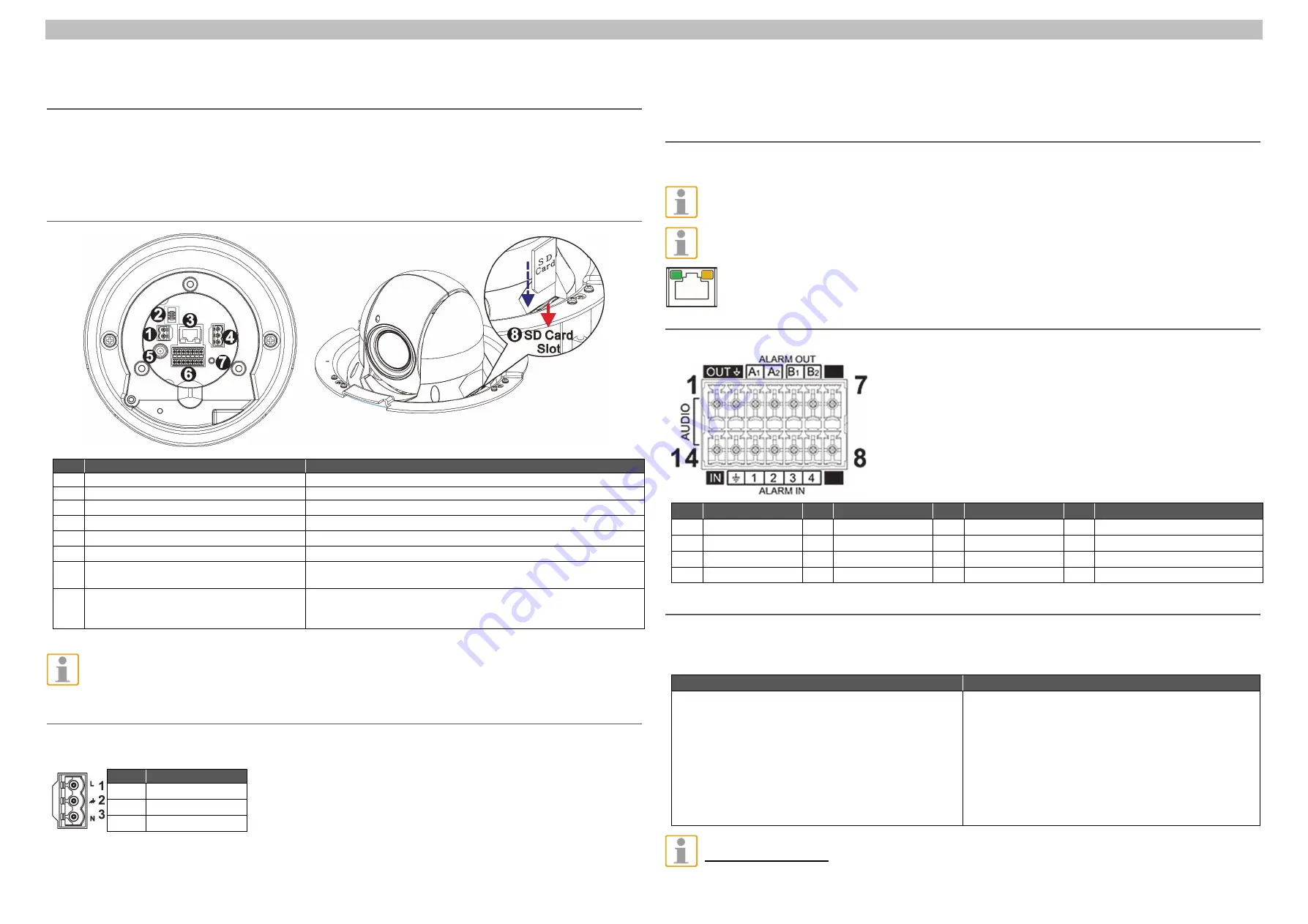
G-Cam/ESD-4510 + G-Cam/ESD-4620 H.265 IP Speeddome Camera Quick Guide
2
3
This guide is for quick installing and connecting the G-Cam/ESD-4xx0 H.265 Network PTZ Camera. For more details,
please refer to the User’s Manual.
Installation Notices
This camera must be installed by qualified personnel and the installation should conform to all local codes.
This camera contains replaceable batteries. To prevent explosion risks, confirm the battery type before replacement.
Dispose of used batteries in accordance with the local regulations.
To use an external power supply, please contact the camera manufacturer to confirm that the power supply uses
the same power specifications as the camera. The power supply must comply with the LPS requirements.
Camera’s Connectors
No.
Connector
Definition
1
Power Connector (DC12V)
DC 12V power connection
2
Console Connector
This connector is used for repair/maintenance only.
3
RJ-45 Port
For network and PoE+ connections
4
Power Connector (AC24V)
AC 24V power connection
5
BNC
For analog video output
6
Audio/Alarm I/O
*
Audio/Alarm I/O connection
7
Reset Button
Press the button with a proper tool for at least 20 seconds to
restore the system.
8
SD Card Slot
Open the dome cover and insert the SD card into the card slot to
store videos and snapshots. Do not remove the SD card when
the camera is powered on.
*Do
NOT
connect external power supply to the alarm I/O connector of the camera.
NOTE:
It is not recommended to record with the SD card for 24/7 continuously, as it may not be able to support
long term continuous data read/write. Please contact the manufacturer of the SD card for information regarding
the reliability and the life expectancy.
Power Connection
To power up the camera, connect the DC 12V or AC 24V power adaptor to the power connector of the camera and the
power outlet. Refer to the diagram and pin definition below for AC24V power connection.
Pin
Definition
1
AC 24V-1
2
GND
3
AC 24V-2
Alternatively, users can use an Ethernet cable and connect it to the RJ-45 port of the camera and an IEEE 802.3at
(PoE+) 2-Pair 30W switch.
Zero Downtime Power Switching (ZDT)
When users connect DC 12V power jack and the RJ-45 port at the same time, the power input comes from the DC
12V connector. If the DC 12V power source fails, the camera will switch power input seamlessly to the RJ-45 port
until the DC 12V power source is restored.
Ethernet Cable Connection
Connect one end of the Ethernet cable to the RJ-45 connector of the camera, and plug the other end of the cable to
the network switch or PC.
NOTE:
In some cases, Ethernet crossover cable might be needed when connecting the camera directly to the
PC.
NOTE:
Check the status of the link indicator and activity indicator LEDs. If the LEDs are unlit, please check
the LAN connection.
Green Link Light indicates good network connection.
Orange Activity Light flashes for network activity indication.
Audio/AIarm I/O Connection
Please refer to the diagram and pin definition tables below for audio/alarm I/O connection.
Pin
Definition
Pin
Definition
Pin
Definition
Pin
Definition
1
Audio Out
5
Alarm Out B1
9
Alarm In 4
13
GND (Alarm I/O)
2
GND (Audio I/O)
6
Alarm Out B2
10
Alarm In 3
14
Audio In
3
Alarm Out A1
7
N. C.
11
Alarm In 2
4
Alarm Out A2
8
N. C.
12
Alarm In 1
Before Login to the Camera
A client program will be automatically installed to the PC when connecting to the camera. Before logging in to the
camera, please ensure downloading the ActiveX control is allowed by either changing the ActiveX controls and plug-
ins or setting Internet’s security level to default. For further details, please refer to the User’s Manual.
ActiveX Controls and Plug-ins Settings
Internet Security Level
Step 1:
Start the Internet Explorer (IE).
Step 2:
Select <Tools> from the main menu of the
browser. Then click on <Internet Options>.
Step 3:
Click on the <Security> tab and select
<Internet>, and click on <Custom level> to
change ActiveX settings.
Step 4:
Set “ActiveX controls and plug-ins” items to
<Prompt> or <Enable>.
Step 1:
Start the IE Internet Explorer (IE).
Step 2:
Select <Tools> from the main menu of the
browser. Then click on <Internet Options>.
Step 3:
Click on the <Security> tab and select
<Internet>.
Step 4:
Down the page, click on <Default Level> and
<OK> to confirm the setting. Close the browser
window, and open a new one later for
accessing the IP camera.
NOTE:
For the system requirement of the web browser, it is required to connect the camera with Microsoft
Internet Explorer 10.0
or later version to ensure smooth operation.


